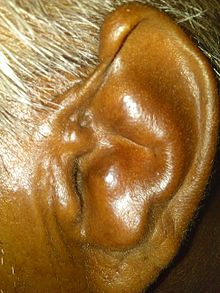Cauliflower ear
| Cauliflower ear | |
|---|---|
 |
|
| Cauliflower ear | |
| Classification and external resources | |
| Specialty | Otorhinolaryngology |
| ICD-10 | M95.1 |
| ICD-9-CM | 738.7 |
Cauliflower ear is an irreversible condition that occurs when the external portion of the ear is hit and develops a blood clot or other collection of fluid under the perichondrium. This separates the cartilage from the overlying perichondrium that supplies its nutrients, causing it to die and resulting in the formation of fibrous tissue in the overlying skin. As a result, the outer ear becomes permanently swollen and deformed, resembling a cauliflower.
The condition is common in martial arts such as boxing, mixed martial arts or wrestling, and in full-contact sports such as rugby union football.
The cause is bleeding within the external portion of the ear, a condition known as hematoma auris, perichondrial hematoma, or traumatic auricular hematoma.
Headgear called a "scrum cap" in rugby, or simply "headgear" or earguard in wrestling and other martial arts, that protects the ears is worn to help prevent this condition. For some athletes, however, a cauliflower ear is considered a badge of courage or experience.
Because an acute hematoma can lead to cauliflower ear, prompt evacuation of the blood is needed to prevent permanent deformity. The outer ear is prone to infections, so antibiotics are usually prescribed. Pressure is applied by bandaging, helping the skin and the cartilage to reconnect. Without medical intervention the ear can suffer serious damage. Disruption of the ear canal is possible. The outer ear may wrinkle, and can become slightly pale due to reduced blood flow; hence the common term "cauliflower ear".Cosmetic procedures are available that can possibly improve the appearance of the ear.
Historically, the condition has usually been seen with wrestlers. An extensive literature and serious science on this condition developed between the 1860s and the turn of the century. It was defined as "An effusion of blood or of bloody serum between the cartilage of the ear and its perichondrium, occurring in certain forms of insanity and sometimes among the sane". Alienists (psychiatrists) advanced various theories linking it to abnormalities of bone, blood, blood vessel (specifically the carotid artery) or brain in the insane. Some thought it was involved in all types of insanity, while others thought it to be worse "in those forms of insanity in which the mental excitement runs high for any length of time".
...
Wikipedia
